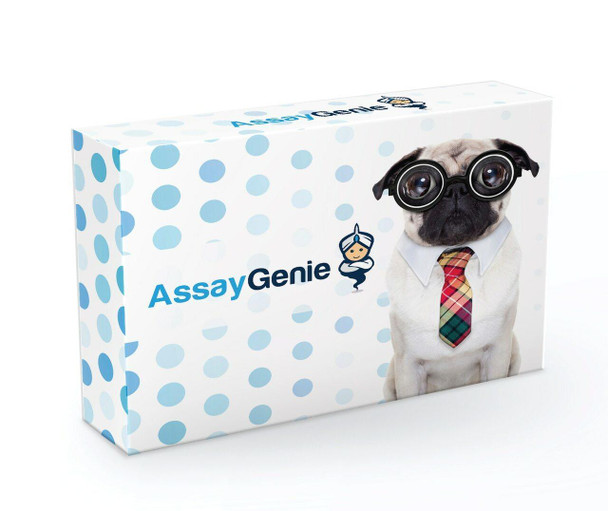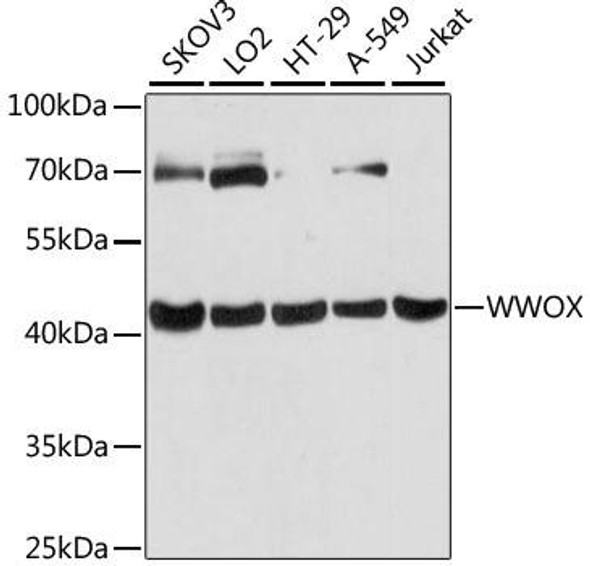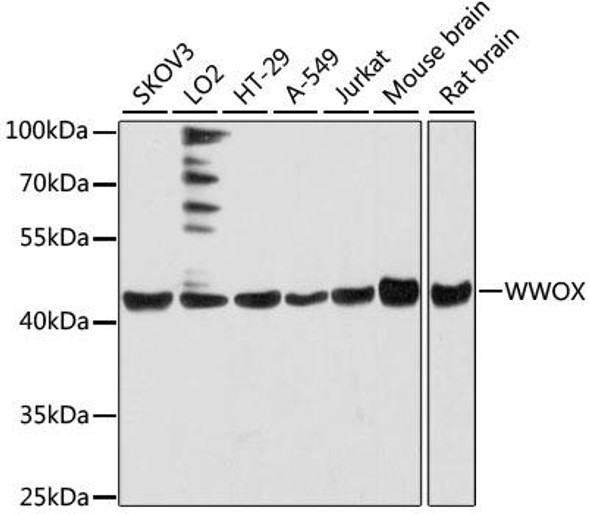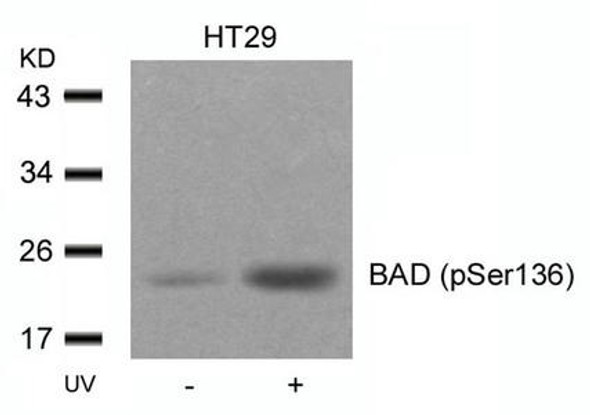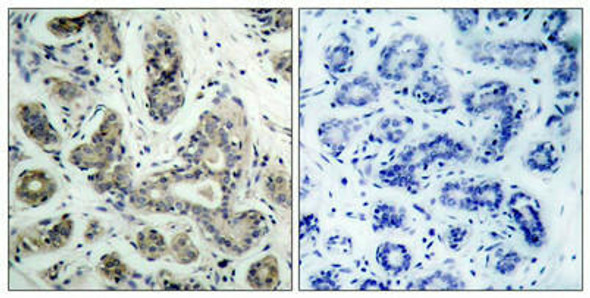Description
Phospho-WWOX (Y33) Antibody (PACO05983)
The Phospho-WWOX (Y33) Antibody (PACO05983) is a valuable tool for researchers studying the phosphorylation status of the WWOX protein. This antibody, developed and validated by AssayGenie, specifically recognizes the phosphorylated form of WWOX at tyrosine 33. WWOX is a tumor suppressor protein that plays a crucial role in regulating cell growth and apoptosis.Phosphorylation of WWOX at tyrosine 33 can modulate its function and signaling pathways, making this antibody essential for studies focused on understanding the molecular mechanisms underlying cancer development and progression.
With high specificity and sensitivity in detecting phospho-WWOX (Y33), this antibody is ideal for use in Western blot applications and other immunological techniques.By investigating the phosphorylation status of WWOX using the Phospho-WWOX (Y33) Antibody, researchers can gain valuable insights into the role of WWOX in cancer biology and potentially uncover new therapeutic targets for cancer treatment. This antibody is a crucial tool for advancing research in oncology and may lead to the development of novel cancer therapies in the future.
| Antibody Name: | Phospho-WWOX (Y33) Antibody (PACO05983) |
| Antibody SKU: | PACO05983 |
| Size: | 50ug |
| Host Species: | Rabbit |
| Tested Applications: | ELISA, WB, IHC |
| Recommended Dilutions: | ELISA:1:10000, WB:1:500-1:2000, IHC:1:100-1:300 |
| Species Reactivity: | Human, Mouse |
| Immunogen: | Synthesized peptide derived from human WWOX around the phosphorylation site of Y33. |
| Form: | Liquid |
| Storage Buffer: | Liquid in PBS containing 50% glycerol, 0.5% BSA and 0.02% sodium azide. |
| Purification Method: | The antibody was affinity-purified from rabbit antiserum by affinity-chromatography using epitope-specific immunogen. |
| Clonality: | Polyclonal |
| Isotype: | IgG |
| Conjugate: | Non-conjugated |
| Synonyms: | WWOX; FOR; WOX1; WW domain-containing oxidoreductase; Fragile site FRA16D oxidoreductase |
| UniProt Protein Function: | WWOX: an enzyme which contains 2 WW domains and a short-chain dehydrogenase/reductase domain (SRD). Expressed at high levels in hormonally regulated tissues such as testis, ovary, and prostate. Its SRD domain suggest a role for this gene in steroid metabolism. Shown to be an essential mediator of tumor necrosis factor-alpha-induced apoptosis in the mouse. May play a similar role in the human. May function as a suppressor of tumor growth. Alternative splicing of this gene generates 7 isoforms. |
| UniProt Protein Details: | Protein type:EC 1.1.1.-; Apoptosis; Oxidoreductase; Tumor suppressor Chromosomal Location of Human Ortholog: 16q23 Cellular Component: cytoplasm; cytosol; Golgi apparatus; microvillus; mitochondrion; nucleus; plasma membrane Molecular Function:coenzyme binding; cofactor binding; enzyme binding; oxidoreductase activity; protein binding; protein dimerization activity Biological Process: negative regulation of Wnt receptor signaling pathway; osteoblast differentiation; positive regulation of transcription from RNA polymerase II promoter; skeletal morphogenesis; steroid metabolic process; Wnt receptor signaling pathway Disease: Epileptic Encephalopathy, Early Infantile, 28 |
| NCBI Summary: | This gene encodes a member of the short-chain dehydrogenases/reductases (SDR) protein family. This gene spans the FRA16D common chromosomal fragile site and appears to function as a tumor suppressor gene. Expression of the encoded protein is able to induce apoptosis, while defects in this gene are associated with multiple types of cancer. Disruption of this gene is also associated with autosomal recessive spinocerebellar ataxia 12. Disruption of a similar gene in mouse results in impaired steroidogenesis, additionally suggesting a metabolic function for the protein. Alternative splicing results in multiple transcript variants. [provided by RefSeq, May 2014] |
| UniProt Code: | Q96KM3 |
| NCBI GenInfo Identifier: | 635172870 |
| NCBI Gene ID: | 51741 |
| NCBI Accession: | NP_001278926.1 |
| UniProt Secondary Accession: | Q96KM3,Q5MYT5, Q96KM3, Q96RF2, Q9BTT8, Q9NPC9, Q9NRF4 Q9NRF5, Q9NRF6, Q9NRK1, Q9NZC5, A8K323, |
| UniProt Related Accession: | Q9NZC7 |
| Molecular Weight: | 23,868 Da |
| NCBI Full Name: | WW domain-containing oxidoreductase isoform 4 |
| NCBI Synonym Full Names: | WW domain containing oxidoreductase |
| NCBI Official Symbol: | WWOX |
| NCBI Official Synonym Symbols: | FOR; WOX1; EIEE28; FRA16D; SCAR12; HHCMA56; PRO0128; SDR41C1; D16S432E |
| NCBI Protein Information: | WW domain-containing oxidoreductase |
| UniProt Protein Name: | WW domain-containing oxidoreductase |
| UniProt Synonym Protein Names: | Fragile site FRA16D oxidoreductase; Short chain dehydrogenase/reductase family 41C member 1 |
| Protein Family: | WW domain-containing oxidoreductase |
| UniProt Gene Name: | WWOX |
| UniProt Entry Name: | WWOX_HUMAN |

